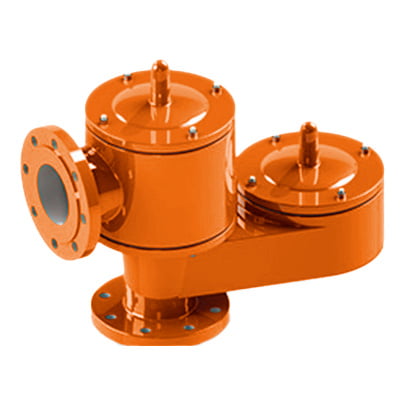Untuk mengukur katup pernafasan dengan benar, ikuti langkah-langkah berikut:
Langkah 1. Tentukan Spesifikasi Tangki
- Ukur diameter dan tinggi tangki.
- Identifikasi lokasi tangki dan kondisi lingkungan yang akan terkena dampaknya.
- Mengumpulkan Material Safety Data Sheet (MSDS) untuk media yang disimpan di dalam tangki, yang meliputi:
*Titik nyala media
*Titik didih media
*Panas laten penguapan
*Massa molekul relatif uap.
Langkah 2. Hitung Laju Aliran Maksimum
Tetapkan laju pengisian maksimum tangki (dalam meter kubik per jam).
Tetapkan laju pengosongan maksimum tangki (dalam meter kubik per jam).
Langkah 3. Tetapkan Persyaratan Tekanan dan Vakum
*Tentukan tekanan internal yang disetel (dalam mbar) yang harus dilepaskan oleh katup.
*Tentukan tekanan vakum yang disetel (dalam mbar) yang harus ditangani oleh katup.
*Pertimbangkan suhu yang disetel dan tentukan apakah jenis ventilasi akan berupa pipa atau atmosferik.
Langkah 4. Pilih Ukuran Katup
*Berdasarkan laju aliran yang diperlukan dan tekanan yang disetel, gunakan perhitungan yang sesuai untuk menentukan ukuran katup. Memanfaatkan standar seperti API 2000 atau ISO 28300 untuk pedoman ukuran yang tepat. Banyak produsen menyediakan perangkat lunak atau bagan ukuran untuk membantu memilih ukuran katup yang tepat.
*Ukuran katup dapat berkisar dari 2″ hingga 12″ (50 hingga 300 mm), tergantung pada persyaratan aplikasi dan perhitungan aliran.
Langkah 5. Material dan Fitur Tambahan
*Pilih bahan katup berdasarkan kompatibilitas media dan kondisi lingkungan. Pilihannya meliputi aluminium, besi ulet, baja tahan karat, baja karbon, dan berbagai paduan.
*Pertimbangkan fitur tambahan seperti lapisan pelindung, sensor alarm, atau desain khusus (misalnya penahan api, mekanisme pegas atau beban berat) sesuai kebutuhan untuk aplikasi spesifik.
Langkah 6. Manfaatkan Dukungan Produsen
Jika ukurannya tidak jelas, banyak produsen menawarkan layanan pengukuran katup untuk memberikan kinerja katup yang optimal dan spesifikasi teknis yang hemat biaya. Kami menawarkan layanan pengukuran dan penghitungan yang disesuaikan dengan kebutuhan pelanggan tertentu.
Dengan mengikuti langkah-langkah ini, Anda dapat memastikan bahwa katup pernafasan memiliki ukuran yang tepat untuk aplikasi Anda, sehingga memberikan perlindungan efektif terhadap tekanan berlebih dan kondisi vakum di tangki penyimpanan Anda.


Katup Pernafasan vs Katup Pelepas Tekanan PRV
Kita semua tahu bahwa memilih katup yang tepat penting untuk memastikan keamanan dan efisiensi [...]
Agustus
Prosedur Uji Katup Pernafasan
Dalam sistem tangki industri, katup pernafasan adalah komponen kunci untuk memastikan bahwa [...]
Agustus
3 Langkah Sederhana untuk Memilih Katup Pernafasan yang Tepat dengan Cepat
YeeValve adalah divisi khusus dari THINKTANK yang membuat katup pernafasan. Kami menawarkan konsultasi gratis [...]
Agustus
Layanan & Dukungan Teknis
1. Bantuan Teknis Yee Valve menawarkan panduan ahli untuk pemilihan, pemasangan, dan pemeliharaan katup. Pelanggan [...]
Mungkin
Daftar Periksa Pesanan
Saat Anda melakukan pemesanan ke Yee Valve, berikut langkah-langkah yang harus Anda ikuti [...]
Mungkin
Bagaimana Mengukur Katup Pernafasan?
Untuk mengukur katup pernafasan dengan benar, ikuti langkah-langkah berikut: Langkah 1. Tentukan Spesifikasi Tangki Ukur [...]
Mungkin